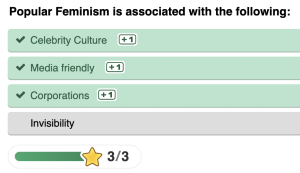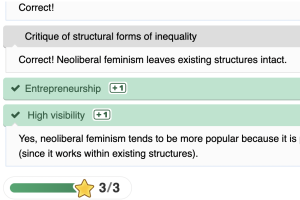3
Section One: The Fundamentals
A) Keywords
Exercise 1:
Briefly (in 100 words or less) define one of the keywords in the padlet (including one that you. may have added yourself).
| Critical race theory is a set of ideas that examines how race and racism intersect with other forms of social inequality, such as class, gender, and sexuality. It challenges traditional legal and social norms, arguing that racism is not just an individual issue but a structural and systemic one embedded in society. It emphasizes the voices and experiences of marginalized groups in understanding and dismantling these inequities. For example, the higher incarceration rates for Black men compared to white men are seen not just as isolated incidents but as symptoms of a system that historically and systematically criminalizes people of color.
|
B) Representing Race
Exercise 2: Notebook Prompt
In about 50-70 words, consider Joel Bervell’s question: why do we feel the need to extrapolate the athleticism of one Black athlete to all Black people when we do not do the same for white athletes?
Try to think of examples when this happens, making sure to reflect on your own positionality.
| This question highlights how Black athletes are more talked about and elaborating their accomplishments and how they are often seen as naturally gifted rather than recognized for their hard work, while white athletes are often praised for discipline and intelligence. Examples include stereotypes about Black runners excelling due to genetics or Black basketball players being “born” for the sport. A specific example of this is Usain Bolt, many believe his Jamaican heritage is behind his winnings. As a white woman who played multiple sports, I never had my athleticism attributed to my race
|
C) Gender, Race & Sport
Exercise 3: Notebook Prompt
What are some strategies for resistance that Rajack and Joseph identify in their article as a means of pushing back against and resisting misogynoir?
| Rajack and Joseph highlight multiple strategies for pushing back against misogynoir. One being through community building and social support. Black women form supportive networks to amplify their voices and create safe spaces where they can share experiences and strategize against oppression. As well as using social media and the digital world as tools for advocacy to call out instances of misogynoir. This is also a way to demand accountability from organizations and businesses to recognize the inequality they are perpetuating. Using self-care as a way to escape to ensure their well-being is taken care of while facing so many injustices. Together, these strategies empower Black women to resist and dismantle misogynoir, fostering solidarity and resilience.
|
Section Two: Making Connections
A) Athlete Activism
Exercise 3: Padlet Prompt
Do athletes have a responsibility to use their platform for social change? Why or why not? Please remember to record your response in both the padlet below and in your Notebook.
Athletes do have a unique opportunity with their visibility and influence to spark or promote social change. Although, whether they should or not is debatable, I say this as some people argue that athletes are primarily performers, not activists, and should focus on their sport. I personally believe that if they are passionate about something then they should use their platform to speak to their audience about it. I think that using their influence outside their sport can be so beneficial for bringing up topics that are often overlooked or ignored in mainstream discourse. For example, beyond Serena Williams incredible tennis career, after her difficult experience with childbirth, she became a vocal advocate for improving healthcare for Black women, pushing back against systemic racism and healthcare disparities. Ultimately, I look at it like a personal choice rather than a “responsibility”, but those who use their influence for positive change can significantly impact societal discourse and encourage others to act as so many people see athletes as role models.
B) Athlete Activism & Feminism
Exercise 4: Complete the activities




Exercise 5: Notebook Prompt
What do the authors of the article call for as a way of challenging how mainstream sports journalism privileges neoliberal feminist concerns? (100 words max.)
| The authors of this article advocate for narratives within the media to recognize systemic inequalities and activism, rather than framing female athletes’ struggles solely through personal resilience. By centering issues like racial justice, anti-patriarchy, labor rights, and institutional discrimination, sports media can challenge dominant gender norms and highlight the broader socio-political stakes of athlete activism. The authors emphasize the need for journalism that critically engages with power structures rather than reinforcing them through empowerment narratives. This will change the way female athletes are seen and thought about, instead of being inspiration porn, they can exist without being known as a ‘hero’ for simply being a woman in sport.
|
C) Corporate social justice
Exercise 6: Padlet Poll
| Expanding on my earlier response, I argued that athletes should see supporting social justice movements as a personal choice rather than an obligation. However, when it comes to sports leagues, I believe they do feel a responsibility to support movements like BLM. Given their influence and visibility, leagues recognize the need to take a stance on social issues, whether due to player activism, public pressure, or corporate interests. While their involvement can sometimes appear performative, their support plays a crucial role in shaping public discourse and advancing social justice initiatives beyond the sports world. I believe that supporting social movements could be so beneficial, as many athletes within the teams are strong supporters or allies within these movements and feel it needs to be addressed while the clock is running. Social issues do not stop for sports, they still exist within the sports world and so it is so important to represent these messages. The article specifically examines the NBA and the NFL, both of which have predominantly Black player bases, and their responses to social justice movements like BLM. These leagues are particularly significant because the vast majority of their athletes are Black, and their involvement in activism brings attention to the racial inequities that impact both the players themselves and the communities they represent. As major sports organizations, the NBA and NFL are deeply intertwined with issues of race, power, and identity, making their stance on social justice crucial.
|
Section Three: Taking a shot
Module Assignment (submit as part of notebook and separately through Blackboard mini assignment #1 portal)
The athlete I am choosing to focus on is Simone Biles as both an athlete and an activist. She appears in two Netflix productions: Simone Biles Rising, which follows her journey as she prepares for her return to the Olympics, and Athlete A, speaking on the abuse faced by gymnasts at the hands of former USA Gymnastics doctor Larry Nassar. Both these productions showcase Biles’ resilience, her fight for justice, and her advocacy for athlete safety and mental health. Biles uses her voice in both of these shows as a way to advocate for athlete safety, mental health awareness, and institutional accountability.
In Simone Biles Rising, we see Biles training to return to the Olympics for more success. Learning her story helps us understand how it informs her activism. For example, her and her siblings spent over 3 years in the foster care system before being adopted by her grandparents. She now works with a non profit organization called “Friends of the Children”. This organization allows for the many children in foster care to be matched with a mentor to help discover their life’s purpose and realize their potential (Friends of Children, n.d.).
In 2020, she withdrew from the Tokyo Olympics due to mental health and a case of the twisties, and experienced backlash. She has moved the mental health conversation in a positive way by simply being open about her experience in therapy and how it allowed her to continue to compete. The backlash Biles faced exemplifies misogynoir which creates a paradox of invisibility and hypervisibility (Razack & Joseph, 2021). Black women’s achievements are minimized, while their presence in media narratives is heightened when they are framed as controversial or non-compliant (Razack & Joseph, 2021). This stands in contrast to how white athletes, such as Michael Phelps or Naomi Osaka, have been largely praised for prioritizing their mental health, highlighting the racialized double standard in sports media.
Biles’s story in Athlete A also brings attention to how race and gender impact sports. Nassar, a powerful white man, used his position to abuse young female athletes, many of whom were women of color. The traditional boundaries of sports media have historically focused on male athletes and mainstream platforms such as ESPN (Razack & Joseph, 2021). Nassar’s power was further reinforced by the institutions that protected him. While all survivors of his abuse faced systemic neglect, Biles’ experience as a Black woman was shaped by broader patterns of racial exclusion in sports media. White survivors, such as Aly Raisman and McKayla Maroney, were often centered in mainstream narratives, whereas Biles had to actively push for recognition of her trauma. Her advocacy disrupts these narratives by forcing conversations about the intersection of race, gender, and power in gymnastics. Biles’ activism aligns with feminist efforts to reshape sport media and amplify diverse voices (Razack & Joseph, 2021).
Through Simone Biles’ journey we can look at sports with a more critical and intersectional lens, understanding that sports are not always glorious as they appear to be. Biles has been an activist for many things that have allowed her to use her own experiences towards good. Biles has been an activist for many causes, such as working closely with the foster care system and shedding light on the mental health struggles athletes face. Challenging the broader systemic issues of racism, sexism, and the unrealistic expectations placed on Black female athletes in sports media narratives.
References
Walsh, K., Chopra, G., Sankaran, A., Parets, G., Miller, J., Taylor, J., Exarchos, Y., Parmentier, J., & Herren, D. (2024). Simone Biles Rising. Netflix.
Friends of the Children. (n.d.). Simone Biles. Friends of the Children. https://friendsofthechildren.org/about/simone-biles
Razack, S., & Joseph, J. (2021). Misogynoir in women’s sport media: race, nation, and diaspora in the representation of Naomi Osaka. Media, Culture & Society, 43(2), 291-308. https://doi-org.proxy1.lib.trentu.ca/10.1177/0163443720960919
Cohen, B., Shenk, J., Sey, J., Marshall, S., & Parker Benello, J. (2020). Athlete A. Netflix. Actual Films.

